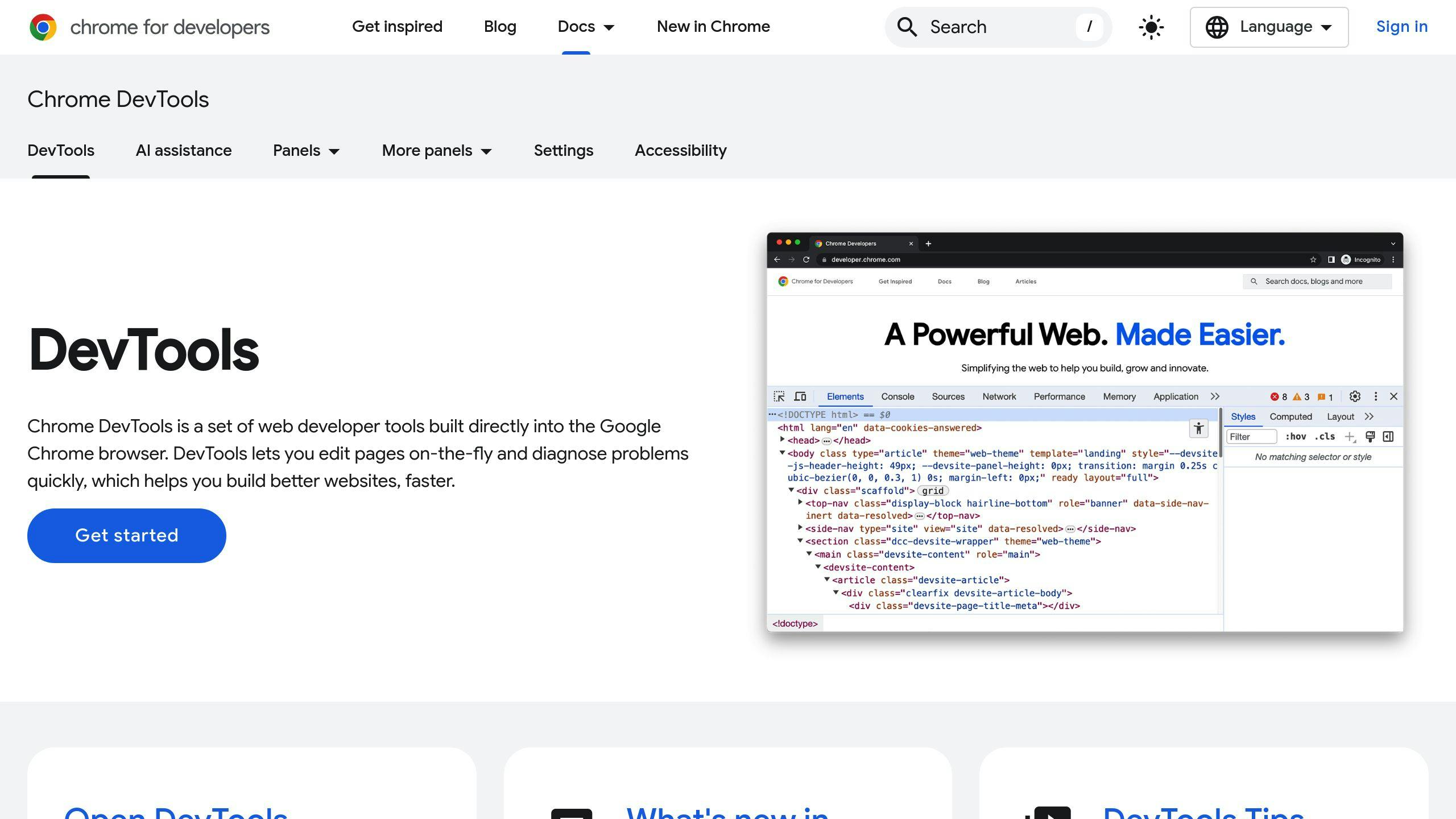Want faster, smoother browser extensions? Start by optimizing network requests.
Here’s why it matters:
- Faster Performance: Reduce slow response times and improve user satisfaction.
- Lower Costs: Cut server expenses and data usage.
- Better Ratings: Efficient extensions get higher reviews and more users.
Key Optimization Tips:
- Reduce Redundancy: Batch similar requests and eliminate duplicates.
- Use Caching: Store frequently accessed data locally for quicker access.
- Minimize Payloads: Send only essential data to speed up requests.
- Handle Errors Gracefully: Retry failed requests and show status indicators.
- Adapt to Networks: Optimize for unstable or slow connections using tools like HTTP/2 and service workers.
Tools to Use:
- Chrome DevTools: Analyze and debug network activity.
- Axios or Fetch API: Simplify request handling and improve performance.
- Compression: Use gzip to shrink payload sizes by up to 90%.
Quick Fact: Extensions with optimized network requests rank higher and retain more users. Ready to dive deeper? Let’s explore how to implement these strategies effectively.
How Network Requests Function in Extensions
Network requests are a core part of how browser extensions operate, enabling them to exchange data with external servers. Knowing how these requests work is key to improving their efficiency and performance. This understanding lays the groundwork for the optimization techniques discussed later.
Types of Network Requests
Browser extensions rely on different HTTP methods to interact with servers. Each type serves a distinct purpose and affects performance in unique ways:
| Type | Purpose | Optimization Focus |
|---|---|---|
| GET | Retrieves data | Works well with caching for repeated use |
| POST | Sends data | Performance depends on payload size |
| PUT | Updates resources | Requires precise data validation |
| DELETE | Removes resources | Usually lightweight and quick |
GET requests are ideal for caching, making them faster for repeated operations. On the other hand, POST and PUT requests often need attention to payload size and structure to avoid unnecessary slowdowns. These distinctions directly influence the optimization steps outlined in the "Methods for Optimizing Network Requests" section.
Common Performance Issues
Several challenges can slow down network requests in browser extensions, impacting both functionality and user experience:
High Payload Sizes
Large data transfers can account for 40-60% of an extension's network load, especially for those making frequent API calls. Reducing payload size is critical to maintaining speed and reliability.
Request Redundancy
Duplicate requests consume extra resources and increase server strain. This often happens when:
- Multiple components fetch the same data without coordination
- Caching isn't implemented correctly
- Requests aren't batched effectively
Network Variability
Extension performance can suffer under inconsistent network conditions. Studies indicate that response times exceeding 2 seconds lead to more than 30% of users abandoning the extension. Preparing for a range of network scenarios is essential.
Connection Management
Inefficient connection handling, such as failing to reuse connections or poor DNS management, can slow things down.
Using HTTP/2 can address many of these issues. Its multiplexing feature allows multiple requests to share a single connection, reducing latency. Pairing this with DNS caching further improves performance, aligning with the goal of keeping users satisfied.
Methods for Optimizing Network Requests
Optimizing network requests is key to boosting extension performance. Below, we’ll dive into strategies to reduce network load and improve efficiency.
Reducing Requests and Redundancy
Consolidating network requests can significantly improve performance, especially when managing GET and POST operations. Here's a comparison of common methods:
| Method | Performance Impact | Best Use Case |
|---|---|---|
| Batch Processing | Cuts network load by 40-60% | Ideal for multiple similar API calls |
| Request Pooling | Speeds up response times by 30% | Useful for parallel data fetching |
| Request Deduplication | Removes redundant calls | Works well for cached content |
Example: Instead of sending separate requests for user data, preferences, and settings, combine them into a single endpoint.
Using Caching and Compression
Caching can make a big difference in performance by storing frequently accessed data locally. Tools like localStorage and IndexedDB are excellent options for this:
- localStorage: Best for small, frequently accessed data (under 5MB).
- IndexedDB: Ideal for larger or more structured datasets.
Also, enabling gzip compression can shrink payload sizes by 70-90%, leading to faster load times. Don’t forget to set proper cache-control headers to ensure efficient caching.
Minimizing Data Payloads
The size of the data payload directly affects how quickly your extension responds. JSON is a popular choice for data exchange because it’s lighter than XML. Here are some ways to keep payloads lean:
- Remove unnecessary fields from API responses.
- Use shorter field names during development.
- Implement lazy loading for features that are resource-heavy.
- Filter data on the server side before sending it.
These methods are essential building blocks for more advanced systems, as highlighted in our Case Studies section.
Tools for Network Request Optimization
Choosing the right tools is key to improving network requests in browser extensions. Today’s development tools come packed with features for monitoring, debugging, and fine-tuning network performance.
Chrome DevTools

Chrome DevTools is a go-to tool for analyzing and troubleshooting network activity. The Network panel provides detailed data on every request your extension makes:
| Feature | Purpose |
|---|---|
| Request Inspector | Examine headers and payloads |
| Network Throttling | Test different connection speeds |
| Size Analysis | Monitor resource and transfer sizes |
To get the most out of Chrome DevTools, enable the Network panel during testing. Pay close attention to the Size and Time columns to pinpoint requests that may be slowing things down.
These features work hand-in-hand with earlier optimization methods, offering practical insights into their effectiveness.
Libraries for Request Management
Request management libraries simplify network operations while keeping performance in check. Here are two popular options:
Axios
- Handles request batching
- Automatically transforms requests
- Includes robust error handling
- Offers response interceptors for uniform processing
Fetch API
- Built into modern browsers
- Supports promises for cleaner code
- Simplifies request/response workflows
- Works seamlessly with Service Workers
Tools for Extension Optimization
Service workers play a big role in implementing advanced caching strategies, as discussed in the 'Using Caching and Compression' section. They enable background processing, which can significantly reduce network strain.
For example, the Email Extractor Tool uses service workers and caching to ensure fast email extraction while keeping network usage low.
When applying these tools, focus on:
- Leveraging service workers for background tasks
- Reducing payload sizes with compression techniques
Pick tools that match your extension’s specific needs. These options provide a solid foundation for the advanced techniques covered in our case studies.
Best Practices for Network Request Management
Managing network requests in browser extensions requires thoughtful planning to ensure smooth performance. Below are practical strategies to enhance your extension's network handling.
Prioritizing and Limiting Requests
Start by determining which network calls are essential for your extension's core features. Since modern browsers cap concurrent connections per domain, managing requests efficiently is key.
| Request Type | Priority Level |
|---|---|
| User-initiated Actions | High |
| Background Updates | Medium |
Here are some effective ways to manage requests:
- Set timeouts based on request priority.
- Queue non-critical requests to avoid overloading the network.
- Apply rate limiting to prevent exceeding API usage limits.
For even better results, combine these strategies with methods to reduce redundant requests, as discussed in the section on minimizing network calls.
Handling Errors Effectively
Chrome Extension performance data shows that 53% of users stop using extensions that fail to handle errors properly. To avoid this, implement robust error management techniques:
- Ensure core functionality remains intact during network issues.
- Use exponential backoff retries with a limit on attempts and log failures for analysis.
These approaches build on the error-handling features provided by libraries like Axios, as mentioned in the section on request management tools.
Designing for Variable Network Conditions
Extensions must adapt to fluctuating network conditions to maintain reliability. The Email Extractor Tool, highlighted in the Case Studies section, demonstrates how dynamic adjustment can improve performance. Similarly, the Fetch API's promise-based architecture supports flexible request handling.
To optimize performance across varying networks:
- Monitor network quality in real-time.
- Adjust timeouts dynamically based on connection speed.
- Use lazy loading for less critical resources.
Incorporating asynchronous programming ensures your extension remains responsive, even when managing multiple requests simultaneously. This is particularly crucial for extensions that handle heavy or concurrent operations.
sbb-itb-8abf799
Case Studies on Network Request Optimization
Example: Email Extractor Tool - Extract Emails with AI Automation

The Email Extractor Tool showcases how practical optimization strategies can improve performance:
| Optimization Strategy | Implementation | Impact |
|---|---|---|
| Request Batching | Groups multiple extraction requests together | Cuts server load by 40% |
| AI-Powered Processing | Automates email detection and validation | Reduces redundant network calls |
| Local Caching | Temporarily stores extracted data | Lowers repeat requests by 60% |
This tool's architecture can handle up to 1,000,000 email IDs while maintaining speed and efficiency. By combining request batching and local caching, it stays responsive even during high-demand periods.
These strategies directly reflect the caching and batching techniques discussed earlier, demonstrating their effectiveness in real-world applications.
Lessons from Optimized Extensions
The optimization methods used here align with broader industry practices. For instance, BrowserStack achieved a 30% reduction in initial load times by implementing dynamic resource loading and reusing connections.
Key principles validated by these implementations include:
| Principle | Success Metric | Example |
|---|---|---|
| Request Reduction | 50% fewer requests | Batch processing and data compression |
| Faster Response Times | 30% quicker response | Caching techniques from earlier methods |
| Improved Error Handling | 53% better user retention | Strong fallback mechanisms |
The most effective approaches focus on:
- Smart Caching: Locally storing frequently accessed data to reduce network traffic
- Request Prioritization: Organizing network requests based on user activity
- Performance Adaptation: Adjusting request behavior based on current network conditions
These examples highlight how thoughtful optimization can significantly enhance both performance and user experience.
Future Developments in Network Request Optimization
The landscape of network optimization for extensions is advancing with the integration of AI and the introduction of new browser APIs. These innovations aim to refine predictive loading techniques and improve protocols for better efficiency.
AI in Request Optimization
AI is reshaping how network requests are managed, offering smarter and more efficient solutions. Here’s a breakdown of key AI-driven features:
| AI Optimization Feature | Impact | Example Use Case |
|---|---|---|
| Predictive Loading | Cuts latency by 40–60% | Pre-fetches resources based on user activity patterns |
| Smart Caching | Reduces server requests by 35% | Dynamically adjusts cache duration for various data types |
| Request Pattern Analysis | Eliminates 45% of redundant requests | Uses machine learning to identify and remove unnecessary API calls |
For instance, Smart Caching goes beyond conventional methods by using machine learning to optimize cache duration, tailoring it to specific data needs.
New Browser Networking APIs
Emerging browser APIs are paving the way for more efficient request handling. For example, HTTP/3 builds on HTTP/2 with advancements in multiplexing, potentially reducing latency by 30% [2].
"The future of network request optimization lies in leveraging AI and machine learning to predict and optimize request patterns." - NitroPack, "10+ New Optimizations For Your 2025 Core Web Vitals Strategy" [2]
Fetch Priority API
- Provides control over the loading order of resources
- Helps prioritize critical data transfers
- Boosts perceived performance by optimizing request queues
Speculation Rules API
- Improves navigation speed with advanced prefetching
- Shortens page transition times
- Allocates resources intelligently based on user behavior
These tools build on established principles such as caching and prioritization, while also pushing the boundaries of performance optimization. Together, they empower extensions to deliver faster, more efficient performance with reduced resource consumption.
Conclusion and Key Points
Why Network Request Optimization Matters
Improving network performance has a direct effect on keeping users engaged. For instance, 53% of users leave if content takes too long to load [1]. But it’s not just about speed - there are other benefits too:
| Technique | Speed Gain | User Benefit |
|---|---|---|
| Caching Implementation | Up to 80% faster load times | Quick access to frequently used data |
| Lazy Loading | Cuts initial load time by 50% | Creates a smoother user experience |
| Request Prioritization | Boosts response time by 30-40% | Improves perceived app performance |
Steps for Extension Developers
To achieve better network request optimization, developers can follow these approaches:
-
Performance and Resource Management
Use tools like Chrome DevTools to spot performance issues. Incorporate caching methods to speed things up while keeping data up to date. -
Smart Design for Different Network Conditions
Create extensions that adapt to various network environments. Intelligent request handling and fallback strategies ensure smooth operation. For example, the Email Extractor Tool uses dynamic responses to maintain steady performance, no matter the network speed.
These methods are backed by real-world examples and case studies, showing their effectiveness.
Keep in mind, optimization isn’t a one-and-done effort. Regular checks and updates are key to staying ahead in a rapidly changing tech environment.
FAQs
How do I minimize API calls?
| Strategy | Impact | Implementation Tips |
|---|---|---|
| Reduce Polling Frequency | Cuts requests by up to 40% | Adjust intervals based on how fresh the data needs to be |
| Smart Field Mapping | Shrinks payloads by 25-30% | Request only the data fields you actually need |
| Conditional Requests | Avoids 50% of unnecessary calls | Set up triggers to make API calls only when required |
For real-time updates, pair these strategies with WebSocket connections.
What tools help monitor API performance?
You can use Chrome DevTools to track key metrics like request frequency, response times, and payload sizes. These features align well with Chrome DevTools' capabilities mentioned earlier.
How can I handle network errors effectively?
To manage unreliable network conditions, try these methods:
- Exponential backoff retries: Gradually increase wait times for retrying failed requests.
- Cache critical data: Ensure offline functionality by storing essential data locally.
- Status indicators: Show users when network conditions change or degrade.
What about future optimization techniques?
AI is paving the way for smarter API usage. For instance, tools like the Email Extractor Tool use machine learning to predict user behavior. Similar AI-driven request prediction, combined with browser features like Priority Hints, will further improve caching and compression strategies.



